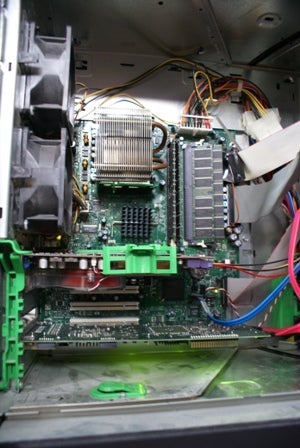Design team members: Mark Wilkinson
Supervisors: Kevin Law
Background
Financial markets are constantly adapting to new technologies becoming faster, smarter and more efficient. Automatic trading allows for a computer system to act on market information within microseconds, sending and modifying tens of thousands of orders in second [1]. As most exchanges execute orders on a time-price priority, a digital arms race has developed amongst competing high-frequency firms, with slower systems at the complete mercy of the fastest system. In order to push the envelope of high-frequency, low-latency trading further it is now necessary to overcome the limitations of traditional computer architecture through hardware acceleration.
Traditionally, optimizing code at the application level was sufficient in order to reduce latencies in the millisecond order of magnitude. However, now that trading times have been lowered into microseconds [2] it is no longer sufficient to mealy optimise application level code, as the inefficiencies found in traditional computer architecture limit the latency achievable by this approach. A number of products and technologies exist which work to overcome many of the latency bottlenecks found in traditional systems, however, as processing still needs to be done at the application level they are unable to achieve the theoretical low latencies possible on FPGA based designs [3].
Investment Technology Group, Inc. (ITG) an industry leader in electronic trading has sponsored this project, providing industry knowledge and resources.
Project description
The overall objective of this project is to, design and implement a hardware accelerated equity trading system optimized for running a cross market strategy. In order to be successful the trading system will need to meet the primary objectives outlined below.
- Ultra Low Latency
- Financial Information eXchange Protocol 4.2 Compliant [4]
- Level One Quote Support
- Implement Cross-Market Strategy
Design methodology
Hardware Selection – Various hardware devices were investigated and analysed with a NetFPGA device proving optimal based on a number of constraints. The NetFPGA allows for gigabit Ethernet connectivity, real-time communication with software and provides a useable framework.

NetFPGA (Bottom card) In Prototype Computer
Network
Communication
–
Successfully
establishing
network
communication
through
the
NetFPGA
is
a
major
milestone
towards
accomplishing
the
objectives
of
this
project.
How
network
communication
is
handled
through
the
FPGA
will
help
to
realise
the
limitations
of
the
NetFPGA
hardware
and
also
shape
the
final
solution
and
prototype.
Trade
System
Integration
-
Once
communication
has
been
established
between
the
application
level,
NetFPGA
and
an
external
test
computer
a
trade
system
can
be
built
onto
this
framework.
The
limitations
discovered
of
the
NetFPGA
hardware
in
how
communication
needs
to
be
handled
will
drastically
influence
how
the
trading
system
is
integrated
and
what
aspects
of
processing
are
handled
on
the
FPGA
and
what
remains
in
software.
The
trading
system
can
be
broken
down
into
two
parts,
the
first
dealing
with
external
communication,
the
FIX
and
quote
engines
and
the
second
the
internal
trading
logic.
Low-Latency
Adjustments
–
In
order
to
achieve
the
desired
low
latency,
a
number
of
unconventional
theoretical
techniques
have
been
drafted
which
will
need
to
be
implemented
and
refined.
More Information
For more information please attend the Systems Design Engineering Design Symposium.
- Solace Systems. Trading microseconds for nanoseconds. September 23, 2009. Accessed November 2010. https://solace.com/blog/trading-microseconds-for-nanoseconds/
- BATS Trading. BATS System Performance. Accessed November2010. http://batstrading.com/resources/features/bats_exchange_Latency.pdf
- in-FPGA Trading Systems. Trade Response Latency Reduced to Under Two Microseconds by Combining NASDAQ ITCH and OUCH into a Single FPGA. September 14, 2010. Accessed November 2010.